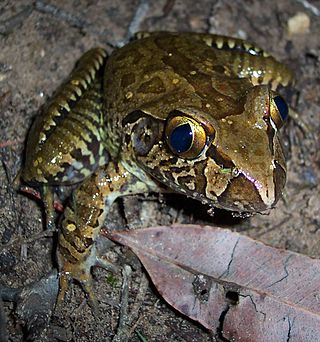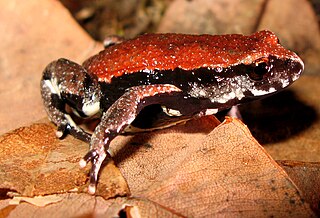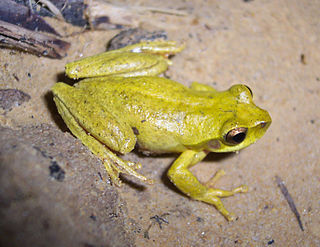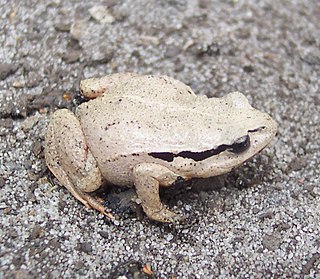
The barred frogs are a group of frogs in the genus Mixophyes. They are the largest of the Australian ground frogs, from the family Myobatrachidae.

The great barred frog is an Australian ground-dwelling frog of the genus Mixophyes.

The giant barred frog is a species of barred frog found in Australia. It occurs from south-eastern Queensland to just south of the Newcastle region in New South Wales. It is associated with flowing streams and creeks in wet sclerophyll and rainforest habitats from the coast to the ranges.

Fletcher's frog, commonly known as the sandpaper frog or black-soled frog, is a species of nocturnal, terrestrial frog native to eastern Australia. It is primarily found in wet sclerophyll forests along mountain ranges and the coast.

The red-backed toadlet is a species of ground frog native to the coast and adjacent ranges of eastern Australia, from just north of Sydney to South-eastern Queensland.

The Blue Mountains tree frog also called the variegated river tree frog is a species of tree frog in the subfamily Pelodryadinae. It is endemic to southeastern Australia and is found in eastern Victoria and in southeastern New South Wales. The Jenolan Caves tree frog, a population formerly separated as Litoria jenolanensis, is nowadays included in this species.

The southern leaf green tree frog is a species of tree frog native to coastal areas and the ranges of south-eastern Australia. It is distributed from just south of Sydney to eastern Victoria.

The leaf green tree frog is a species of stream-dwelling frog, native to eastern Australia from the Queensland/New South Wales border south to Sydney.

The revealed frog, whirring tree frog, or orange-thighed treefrog is a species of tree frog native to coastal eastern Australia.

Haswell's frog is a small ground frog found around coastal swamps in eastern Australia from around Port Macquarie, New South Wales to the Mornington Peninsula in Victoria. It is the only member of the genus Paracrinia.

The mountain stream tree frog is a species of tree frog native to highland areas of NSW, Australia stretching from the Myall Lakes area, north to around Dorrigo National Park and west to Barrington Tops National Park.

Pearson's green tree frog, also known as the cascade tree frog, is a species of tree frog inhabiting rainforest creeks from north of Lismore, New South Wales, to Kenilworth, Queensland, with a disjunct population at Kroombit Tops Queensland, Australia.

Fleay's barred frog is a large species of frog restricted to small pockets of rainforest in northern New South Wales and south-eastern Queensland, Australia.

The northern barred frog is a large, ground dwelling frog native to tropical northern Queensland, Australia.

Hyalinobatrachium pellucidum, also known as the Rio Azuela glass frog, is a species of frog in the family Centrolenidae. It is found in lower montane rainforests on the Amazonian Andean slopes in Ecuador and Peru. The specific name pellucidum is Latin for "transparent" and refers to the transparent parietal peritoneum of this species.

Allobates ornatus is a species of frog in the family Aromobatidae. It is endemic to northern Peru where it is only known from near its type locality, Tarapoto in the San Martín Province, on the eastern slopes of the Cordillera Oriental.

Petropedetes cameronensis, sometimes known as the Cameroon water frog, is a species of frog in the family Petropedetidae. It is found in southeastern Nigeria, southwestern Cameroon, and on the island of Bioko. It is the type species of the genus Petropedetes.
Theloderma nebulosum, the misty moss frog, is a species of frogs in the family Rhacophoridae. It is endemic to central Vietnam and currently only known from Ngọc Linh Nature Reserve in the Kon Tum Province. Only one female and a series of tadpoles collected in 2009–2010 are known. This species, together with Theloderma palliatum, was described by Australian and Vietnamese scientists in 2011.
Osteocephalus castaneicola is a species of frog in the family Hylidae. It is found in lowland Amazonia of northern Bolivia, adjacent southeastern Peru, and western Brazil. It breeds in water-filled fruit capsules of the Brazil nut, a characteristic also alluded to in its specific name castaneicola derived from the Latin castanea, the root of the vernacular name castaña for the Brazil nut, together with the Latin colō meaning "to inhabit".
The southern stuttering frog is a large species of frog endemic to south-eastern Australia. It is found in mid-eastern New South Wales and at least formerly Victoria, where it ranges from Carrai National Park south to East Gippsland. It inhabits temperate and subtropical rainforest, wet sclerophyll forest, and moist gullies in dry forests.


















